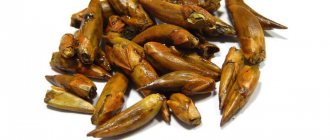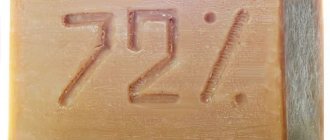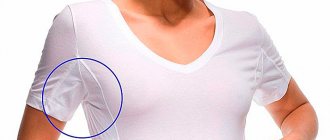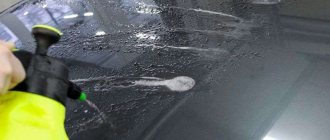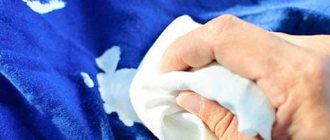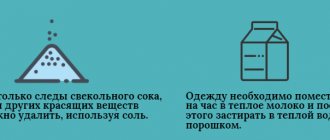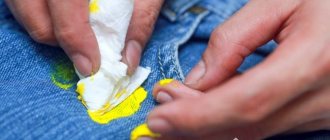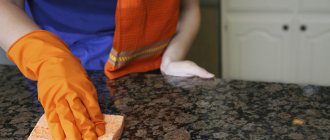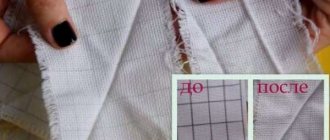During the period of swelling of the buds, Velcro and resin actively fall from the poplars. This sticky yellow substance easily ends up on clothes and shoes. As a result, yellow stains remain on the products, which are quite difficult to remove. They eat firmly and deeply into the fibers of the fabric. However, standard washing will not remove resin, Velcro and greasy marks.
The fact is that the adhesive substance that poplar produces is a chemical polymer compound. It is insoluble in water, alkaline solutions and even some acids. But you can still remove stains from poplar using improvised or special means. Let's find out how to wash poplar from clothes.
What remedies will not help?
Poplar stains are complex chemical compounds of polymers, so you won’t be able to get rid of them using conventional substances.
You should not use washing powders or laundry soap; they will not work on these stains. It has been scientifically found that these polymers are easily destroyed under the influence of concentrated nitric or hydrobromic acid. However, these products are not suitable for cleaning fabric because they will easily leave holes in it.
And for synthetic materials it is forbidden to use even chlorine and acetone, since they render such things unusable. But there are several ways to help save your favorite clothes without harming them.
Professional products
You can always use special stain removers. They contain components that penetrate deep into the fibers and clean the product in a few minutes. However, in this case, such compositions cannot help every time, although they effectively cope with old and difficult stains and remove stains of grease, food and drinks.
Vanish, Faberlic and Amway products help a lot. These are universal preparations that are suitable for clothing, upholstered furniture and carpets. For white cotton and linen clothing, use chlorine bleach. For non-ferrous materials and synthetics - powders with enzymatic cleaners.
You can use standard laundry soap. It contains an increased number of acids, due to which it can remove fresh yellow and sticky stains. Lather the contaminated area, leave for half an hour and rinse, finally wash in the washing machine or by hand with a suitable powder or gel.
Instead of laundry soap, you can use special Antipyatin soap. This is an inexpensive, safe and accessible product that easily removes various types of contaminants. It does not cause allergies and is even suitable for washing children's clothes. For the best way to wash children's clothes, see the link https://vsepodomu.ru/stirka/luchshee-sredstvo-dlya-detskogo-beliya/.
Cleaning light fabric
You can remove poplar resin from perfectly white clothes using liquid bleach. The product is applied according to the instructions directly to the stain and then washed off with laundry soap. However, it can only be used on the wrong side of the material, otherwise it can be damaged.
If you are not too sure about the safety of a given substance, first try it on a small, inconspicuous piece of fabric and see how it reacts. If nothing unusual happens, feel free to use the product on the problem area. Do not touch the bleach with your bare hands, and be sure to protect your skin with rubber gloves.
If you don’t find such a remedy at home, you can take Domestos or any other substance with an identical composition instead.
Lemon juice is also a good solution for cleaning white T-shirts. Squeeze it out of half a fruit and apply it to the problem area for 10 minutes, then wash the material thoroughly and examine it.
If small marks still remain, repeat the procedure. To remove residue from fabric, use laundry or other alkaline soap.
How to scrub with special compounds at home?
Many housewives do not trust folk recipes and prefer to use special chemistry . Each product has clear instructions for use and guarantees safe use.
To choose a suitable stain remover, you need to focus on its spectrum of action, cost, consumption, and effectiveness.
Dr. Beckmann Expert
Liquid stain remover from a German manufacturer is designed to remove:
- resins,
- bitumen,
- machine oil,
- lubricants
Suitable for stubborn stains on white and colored fabrics. The average price of a bottle (50 ml) is 200 rubles.
The product is used as follows:
- Wet the stain well with the liquid.
- Cover the treated area and leave for a while.
- Carefully blot the dissolved resin with a napkin.
Dr. Beckmann Expert should not be used for cleaning carpets and leather goods.
Koch Chemie Flecken Wasser
The stain remover is designed to remove:
- oil stains,
- ink,
- resins,
- wax,
- lipstick,
- glue,
- fresh paint.
Can be used on:
- textiles,
- carpets,
- glass,
- plastic,
- metal
A liter bottle costs about 850 rubles.
Instructions for use include the following processing steps:
- The liquid is applied to the problem area with a napkin.
- In case of heavy contamination, wait for 3-4 minutes.
- Wipe the stain with a clean cloth using collecting movements.
- Treat stubborn stains with a brush or stiff sponge.
After applying Koch Chemie FleckenWasser, the product must be wiped along the grain with a napkin or sponge.
Mellerud
A special cleaning product from Germany helps deal with stains:
- glue,
- resins,
- lipstick,
- ink,
- carcasses,
- oils,
- soot
The stain remover can be used to clean:
- fabrics,
- wood,
- PVC,
- ceramics,
- glass,
- stone
A 250 ml bottle sells for 460 rubles.
The algorithm for using Mellerud is as follows:
- The liquid is applied to the resinous stain with a cloth.
- They last for a short time.
- Starting from the edges, remove the resin with a clean cloth.
Mellerud is highly flammable and must be stored away from sources of fire.
Removing marks from colored clothes
In order not to damage the paint on the fabric and at the same time wash off the Velcro, you should use less aggressive products. For example, acetone will help you. Apply a small amount to a cotton pad and rub it over the affected area until the poplar marks disappear.
After treatment, be sure to wash the item thoroughly using laundry soap and air it in fresh air to get rid of the unpleasant odor.
Acetone can be purchased at any home improvement store, but if you don't have that option, use regular nail polish remover. Just be sure to pay attention to its composition.
If there is no acetone in it, the product will not help. It would be better if there are no aromatic oils or other additives among the ingredients; they make the substance less effective.
Alcohol, turpentine, white spirit or another solvent will also help remove kidney stains. If the fabric is quite stiff and durable (for example, jeans), you can use them in their pure form. Apply the product using a cotton swab with light movements, trying not to touch the material itself.
If you need to clean delicate fabric, dilute the solvent in half with egg yolk and mix thoroughly. After this, spread the product in a thick layer on the fabric and wait 5-6 hours, and then wash.
Nastya found a nail polish remover without dyes or fragrances. It turned out that using it to wash poplar buds is quite easy. Don't forget that before removing poplar stains, you need to test the product on an inconspicuous area. For example, on the seam from the wrong side. Then you will definitely not damage your favorite things.
Similar materials
All housewives know that it is extremely difficult to wash poplar buds. Stains become firmly embedded in clothing and are simply impossible to remove by simple washing. Various methods can come to the rescue, including folk remedies and household chemicals.
General tips and handy tools
Whitening the soles of sneakers at home is a delicate science. The same product can clean some sneakers and ruin others. There are several subtleties and tricks that will help make the cleaning process more competent and easier.
- A toothbrush with stiff bristles. It is better to clean the white soles of sneakers with its help. It will have an effective effect on stains and will save more energy.
- For white sneakers - a white rag. Colored rags can “give up” their color when exposed to various chemicals. As a result of cleaning, colored stains will appear on the shoes.
- Cotton swabs for cleaning hard-to-reach places. You can also use small screwdrivers, wrapping them in a layer of fabric.
- Gentle cleaning first. If gentle methods do not help, only then move on to more intense ones. Although it is better to immediately get rid of paint with acetone.
- Secure the result with a special shoe polish. For white soles you need white or clear cream. It is applied after cleaning to dry shoes.
The main difficulties in removing stains
To understand what means can be used to treat stains from linden and poplar buds, you need to understand a little deeper what the resin of these trees represents.
In composition, it is a combination of several polymers that can firmly and very quickly eat into any surface. Absorption into the fabric occurs instantly, so many housewives know that dealing with traces of resin is a difficult and sometimes almost hopeless process. After all, all washing powders and bleaches are created to remove completely different contaminants, but they are not effective when working with tree resin. Prolonged soaking, frequent washing, and the use of physical force will not help to wash poplar buds.
Substances that can remove traces of poplar and linden buds are solvents that contain acetone and more aggressive components. They enter into a chemical reaction with the resin and destroy traces of its presence on clothing. Substances that can quickly remove traces of linden and poplar buds include:
- Hydrobromic acid is an effective but extremely toxic agent that can be harmful to health. It is not used for household needs, even if there is a need to wash the linden;
- Nitric acid concentrate is an equally hazardous substance that is not suitable for cleaning clothes at home;
- Acetone is a solvent that can be used to remove linden or poplar buds from clothes, but you must follow the rules of use;
- Sodium hypochlorite is a chlorine bleach that is often used to remove a variety of stains on white fabrics, including linden and poplar buds.
Among the products that can certainly cope with the task, there are only two that, although with extreme caution, can still be used to clean clothes stained with linden. Do not forget that they can only help with minor stains and only on the condition that the fabric that will be processed is of high quality and durable.
Why are linden and poplar stains so persistent?
Previously, residents planted many lindens and poplars in each yard in order to landscape the yard area. But no one thought that these trees would cause so many problems. At the beginning of spring, benches, borders, windows in apartments and other surfaces are covered with yellow marks, and if children are walking in the yard, then so are their clothes.
When poplar and linden pollen gets on items of clothing, it leaves yellow, difficult-to-remove marks. Accordingly, for any housewife they turn into a real problem, and not everyone knows how to wash poplar buds from clothes.
For car owners, this problem is easier to solve. It is enough to purchase a special product at a car dealership and clean the car with it. But washing clothes is a much more difficult task.
There are situations when contamination from linden was not immediately noticed. It has already managed to properly saturate the fibers of the fabric and be absorbed into the material. It is very difficult, and sometimes even impossible, to remove these traces. Regular washing or soaking with powder will not remove such stains from the surface.
Important! Linden resin is a chemical compound of polymers that is difficult to remove with ordinary water, and even an alkali solution is powerless here. The resin is absorbed into the fabric so quickly that rarely does anyone succeed in getting rid of it without damaging the material.
How to wash linden and poplar on clothes using folk remedies
Since it is extremely difficult to remove a stain from a poplar bud, and the use of aggressive agents is dangerous, it is worth starting with the advice that has been proven over the years. Among the popular methods, the following options can be distinguished:
- Using acetone-based nail polish remover (if it is replaced by other components, then using the liquid is useless). It’s easy to wash poplar buds with nail polish remover: you just need to treat the stain with a cotton pad. If after the procedure there are stains on the fabric, then it is necessary to rinse the item with vinegar;
- Heat treatment of things. To remove the resin, it must be heated. To do this, the product is covered on both sides with paper or cloth (preferably white) and carefully ironed with an iron, under which it is necessary to place a sheet of paper so that the iron platform does not stick to the resin, which will be absorbed into the bed fabric;
- Among the solvents, one can note a product that is very safe for fabric and human health - ethyl alcohol. It needs to be applied to a cotton pad and treated the problem area. This method will help remove Velcro from poplar on large items that are difficult to remove;
- Kerosene or gasoline. These substances should only be used in desperate situations, as they can harm clothing and leave behind a very persistent and unpleasant odor. A cotton swab should be moistened in liquid, treated the surface, washed in a basin by hand, and then immersed in the washing machine (this is necessary so that the smell of fuel is not absorbed into the drum);
- Gasoline can also be used on delicate fabrics, but it must be mixed with egg yolk. To do this, you need to take 1 tablespoon of fuel, 1 yolk and mix the ingredients thoroughly. Apply the mixture to the stain from linden or poplar buds, leave for 5 hours, wash in the usual way;
- In addition, you can use turpentine, which is mixed in equal proportions with egg yolk, applied to the mark of linden buds and, after 5 hours of infusion, washed off with powder. If the stain cannot be removed the first time, the procedure can be repeated;
- Since ancient times, turpentine has been mixed with tooth powder. This product helps eliminate various contaminants, even those as persistent as resin from linden buds. In a bowl, combine equal parts of powder and flammable material (you can purchase it at a hardware store), stir thoroughly to obtain a mass similar to sour cream. Apply the product to the contaminated area and leave for several hours. Then wash the product and dry it in fresh air to eliminate the persistent smell of turpentine;
- This complex mixture can also remove linden stains from clothes: a tablespoon of acetone, the same amount of vinegar, ½ spoon of glycerin, 2 teaspoons of soda. Mix all the ingredients, apply to the stain and wait until the linden trace is completely dissolved. If there is no reaction after 2 hours, you can add a little more acetone to the mixture and reapply it to the problem area.
Important! All products, even those with the most harmless components, can negatively affect the condition of the product being processed. Therefore, before applying to the stain itself, it is better to test the color fastness on an inconspicuous area, so as not to remove the color along with the traces of poplar buds.
How to wash linden and poplar from clothes using household chemicals
To wash off linden on clothes, you will have to put in a lot of effort. If folk remedies turn out to be ineffective or there is no desire to experiment, you can also use household chemicals.
- Chlorine-containing bleaches - they are used only on white things that are resistant to aggressive substances. The most popular and widespread remedy is ordinary whiteness. It is best to try to wash linden or poplar buds with gel: it does not spread over the rest of the surface and has a targeted effect.
- Laundry soap . You can try to scrub poplar and linden from clothes with this universal soap, which contains a large amount of alkali. Rub the stain with soap and leave for several hours. Wash in a machine with the addition of baking soda, which can be poured into the powder compartment.
- Domestos or similar products in liquid form. You can use the product only on light-colored clothing, apply it to a trace of linden or poplar and leave for a few minutes.
- Powders for cleaning various contaminants that are used by housewives in everyday life. It is worth giving preference to universal products that can remove fatty deposits, rust, and limescale. Sprinkle the powder onto the dampened poplar stain and rub a little, being careful not to spoil the fabric. Wash after 30 minutes.
Attention! All household chemicals can negatively affect not only the color of the product, but also the structure of the fabric itself. Therefore, they should be used as a last resort and only with preliminary testing on an inconspicuous area of clothing.
To effectively remove stains from poplar, you need to take into account a number of general recommendations:
- It is easier to remove any stain if it is fresh. Therefore, the resin should be removed as quickly as possible: this way it will not have time to be firmly absorbed into the fabric. If poplar buds get on your clothes during a walk, you can take emergency measures by applying a little eau de toilette or perfume to the stain;
- If, after using solvents, an unpleasant odor remains on your clothes, you should hang the item in fresh air or wash it additionally;
- If stains from linden or poplar buds are old, then only an aggressive agent can remove traces of buds. Before using it, you should take care of your own safety: work should be carried out with gloves, with access to fresh air.
Machine wash: 4 rules
The washing machine will remove dirt not only from the sole, but also from the entire surface of the sneakers. However, the method is only suitable for good quality rag products. Suede or leather shoes cannot be machine washed. This doesn't just apply to sneakers. For example, leather sandals will lose their shape irrevocably after spinning in a drum. Also, do not put low-quality shoes into the drum - they will come apart in the machine or come apart at the seams. If machine washable, follow these four rules.
- Special bag. Use a special bag for washing shoes. This reduces the risk of damaging the drum or the shoes themselves. Alternatively, use a scrap pillowcase or wrap your sneakers in a piece of white fabric and tie it in a knot.
- Choosing washing powder. Depending on the color of your sneakers, choose a powder for colored or white laundry. For pure white sneakers, add bleach.
- Washing mode. Wash on a sports shoe or delicate cycle at a temperature not exceeding 30°C.
- Spin mode. Press at minimum speed.
Complexity of poplar stains
Poplar stains cannot be washed or soaked in soapy water. The sooner you try to remove a poplar stain, the more chances you have to keep your favorite item. Resin has a polymer structure that cannot be removed with water or alkali. Standard washing does not remove the greasy traces of poplars; washing powders are designed to remove light stains. In order to wash off the secretion of linden buds, it is worth trying a couple of methods. First of all, a substance that can react with resin.
Chemists have found that resins can dissolve in:
- concentrated nitric acid;
- hydrobromic acid;
- bleach based on chlorine.
Of the listed solvents, only some are suitable for use at home. Nitric acid is harmful to human health (concentrate), and hydrobromic acid damages tissue.
Clothes made from natural fibers and undyed are more susceptible to acids.
Poplar buds leave extremely stubborn stains
Methods for dealing with poplar stains
Removal of the poplar substance is required in the shortest possible time. Efficiency is the key to victory over undesirable consequences. The first step is to remove the kidney (you should follow safety precautions, because it is difficult to wash your hands afterwards); it is not recommended to smear the remaining sticky substance. The damaged item, shoes, is carefully removed, the damaged area is treated with lemon juice and left for ten minutes. The next mandatory step is washing. If it was not possible to wash it the first time, there are additional methods that can remove even caustic stains.
Acetone or a nail polish remover containing acetone (available at a hardware store or pharmacy) helps to remove poplar resin.
It is worth considering that in addition to acetone, such products use additives in the form of essential oils or oil vitamins (vitamin E or A). Otherwise, instead of a solid stain, greasy stains will remain on things. Technical acetone is used in construction (diluting paints or varnishes) and, despite the pungent odor, it easily removes resin. The only caveat is that after using such a solvent, things are ventilated outside for a couple of days.
For cars, the stages of kidney removal are different. To begin with, use a wet cloth, wrung out three or four times, to remove the sticky yellow substance. If desired, it is possible to remove the bud with your hands, but it is worth remembering that by crushing the bud, the rest of the resin will flow out of it (it is difficult to wash the surfaces of the palms and skin, and redness remains afterwards). You can remove stubborn stains using a cotton swab moistened with alcohol.
For final treatment, a special car detergent is suitable. There are products on the market designed to combat tar stains, but they are expensive.
A common problem in spring is sticky stains on shoes, often on the soles. Sub-zero temperatures help get rid of linden velcro on shoes. Stains that have been frozen for a couple of hours can be easily removed (the freezer or vegetable compartment of the refrigerator is suitable for this).
You can remove linden stains from your car with a swab soaked in alcohol.
Additional Helpers
Gasoline will help in the fight against poplar stains. Things after this treatment are washed with double the amount of washing powder. Don't be alarmed by the strong smell of gasoline; after a second wash, it disappears.
White clothes are treated with bleach. Substances containing bleach destroy traces of resin, but in the case of colored fabrics they cause loss of brightness. It is worth remembering that bleach, in addition to its advantages, gives clothes whiteness and depletes the fibers of the fabric. It is not recommended to overuse bleach.
Alcohol can get rid of linden stains. You need to wipe the stain with a cotton swab soaked in it, and then thoroughly wash the residue with water and laundry soap. Household milk is regularly used to remove resin. This is due to the alkaline composition of the soap.
Folk remedies surprise with their diversity. So a mixture of half a cup of turpentine with a teaspoon of egg yolk is applied to the damaged area and left for five hours (overnight for convenience). After washing the stains were gone.
People usually remove stains exclusively with turpentine, and light-colored items with soapy water.
With the arrival of spring, inconveniences arise, housewives wonder how to get rid of traces of linden or how to ensure cleanliness in the house? But with its abundance of diversity, this time of year brings us a bouquet of wonderful aromas and beauty.
In the article we discuss how to wash linden from clothes using traditional methods - alcohol, solvents, laundry soap, using high temperatures. By applying our recommendations, you will learn how to remove tar stains from various types of fabrics correctly and without leaving a trace.
Rules for removing linden stains from clothes
How to remove stains from poplar or linden buds from clothes? This question haunts housewives every spring and causes a lot of headaches. The resin penetrates deeply into the fibers, firmly fixing the yellow plant pigment in the fabric. Don’t rush to throw away your favorite thing - everything can be fixed. But you need to act quickly and as carefully as possible.
To make the linden stain easier to remove, warm the fabric with an iron
Tips on how to remove linden or poplar from clothes:
- Don't delay cleaning. The fresher the stain, the greater the chance of success. Once the resin gets into the fabric and dries, it will be much more difficult to wash it off.
- Do not rub the stain. The first reaction when we discover dirt is to wipe it off. In the case of linden, this is unacceptable. Just peel off the bud if there is one on your clothes and hurry home.
- Check the product for aggressiveness. Don't start cleaning right away. Whichever recipe you choose, first apply a small amount to an inconspicuous area of the fabric on the wrong side and leave for about 15-30 minutes. If the fabric has not changed its structure and color, the composition is suitable for you.
- Heat the spot. It has been noticed that if, before you begin to wash stains from poplar buds, you heat the stain with a hairdryer, it will be easier to remove it. This is explained by the fact that the resin softens when heated and, accordingly, is better amenable to the cleaning composition.
If you are prone to allergic reactions, be sure to wear rubber gloves and thoroughly ventilate the room after the procedure.
How to wash poplar buds? - Theoretical knowledge
In order to understand how to wash poplar buds from clothes, you need to remember a little school chemistry course. It is necessary to choose a product that dissolves the tarry base of the stain. Among all the solvents of the resinous base, several preparations can be distinguished:
Nitric acid
Nitric acid is the most effective way to remove linden from clothes. But due to its properties harmful to the human body, it should not be used for these purposes.
Hydrobromic acid
This tool can also quickly and easily solve the problem. But for the same reason as nitric acid, it is not used in this case.
Acetone
This product will help remove unattractive stains from clothes without harming human health. Of course, the last condition is only possible if the safety rules when working with acetone are observed.
Bleach
Chlorine-containing bleach is available to almost every housewife. Its big disadvantage is the very strong smell. Therefore, such a product should be used with extreme caution to remove linden from clothes.
Conclusion
Of all the options proposed above, only two will not cause much harm to human health: acetone and bleach. Apply one of the stain removers to your clothing. Perhaps it will be effective.
Important! Clothing made from natural fabrics in calm shades has a better chance of getting rid of yellow poplar marks.
Methods for removing linden stains from clothes
Not all tips on how to remove linden or poplar from clothes are equally good. Many of the products offered on the Internet are very aggressive and can damage the fabric or color of the item.
What you shouldn’t do when removing linden or poplar stains from clothes:
- Acid (nitric, hydrobromic, etc.). Despite the fact that the resin must dissolve in acid, this is an aggressive substance and is unacceptable for fabrics.
- Automotive chemistry. Products like the well-known Antitopol composition save the paintwork of a car, but are completely unsuitable for cleaning clothes.
- Gels for washing dishes. Resin stains do not have a fatty base, so products like “Fairy” will simply be useless, although they will not harm the fabric.
Below we will look at how and what you can use to effectively remove buds from poplar or linden on clothes, without the risk of completely ruining your favorite item.
Heat treatment
Is it possible to wash linden from clothes without using chemicals at all? Yes, if you use the laws of physics correctly. You only need one household appliance - an iron.
Turn the item inside out and place a paper towel under the stain from the front side
. Set the iron to the highest possible temperature for this type of fabric - this information is on the clothing label. Heat the stain from the reverse side by pressing the iron against the fabric for a few seconds. The resin will soften and soak into the towel. The towel must be changed to a clean one every time, otherwise you risk transferring the stain to another place. Finally, wash the item as usual.
The procedure for removing stains with an iron is not quick, but it is absolutely safe, since no chemical compounds are used, and correctly selected temperature conditions do not threaten the structure of the fabric.
Laundry soap
Regular 72% laundry soap is what you can use to remove linden from clothes. Provided that the contamination is fresh. The product dissolves resinous compounds and is absolutely safe for fibers - you can safely wash colored and delicate fabrics.
Remove the bud if it remains on clothing. If the resin is dry, heat it with a hairdryer. From the wrong side, soap the stained area and leave to soak for half an hour - an hour. Then the stain can be gently rubbed and rinsed under running water. If the resin does not come off completely, repeat the procedure.
With the same success, you can use Antipyatin soap or, for example, laundry soap from Duru. These products have also proven themselves to be excellent in the fight against stains.
Solvents
Solvents can be used, but you need to take into account the structure and color of the fabric. The safest substance is turpentine. It can be used for dark-colored fabrics.
Ingredients
:
- Turpentine - 0.5 tsp.
- Chicken egg yolk - 0.5 tsp.
How to cook
: Mix the ingredients thoroughly.
How to use
: Apply the mixture thickly to the stain. Leave for at least 5 hours, or overnight. Then simply wash with soap and rinse under water.
Result
: The resin dissolves and the stain is removed without a trace.
In this way you can easily remove a poplar stain, for example, from jeans. What can you substitute for turpentine in a recipe? White spirit is fine.
Another effective way to remove resin from clothes is to wipe it off with acetone. It is better to use pure acetone, but in extreme cases, acetone-containing (this is important) nail polish remover will do. The main thing is that the composition does not contain oils and dyes - they will leave stains, and the product itself will work much worse. According to reviews, the nail degreaser has also worked well - the effect is the same.
Just soak a cotton swab or disk in the liquid and gently, without pressing, rub the stain. The procedure may have to be repeated more than once. Then wash the item as usual.
How to remove linden stains on white? You can use chlorine-containing bleach, for example, regular “Belizna” or “Domestos”. You need to apply the product from the wrong side with a cotton swab, trying not to go beyond the boundaries of the stain. Then wash the item as usual.
Solvents should not be used on delicate or acetate fabrics. For all other materials it is possible, but only after testing the composition on an inconspicuous area of clothing.
Alcohol
Stains from linden or poplar are susceptible to alcohol. Here it is important to use pure alcohol, ideally medical alcohol, since it does not contain foreign impurities. You can try alcohol-containing products (for example, vodka or cologne), but the effect will be much worse. And if the composition contains dyes or oils, then unsightly stains will remain.
The procedure is standard: soak a cotton swab or pad in alcohol and rub the stain. Repeat the procedure until the contamination is completely dissolved.
For more information on how to remove linden stains, watch the video:
How to remove stains from poplar Velcro
There is such a substance - sodium hypochlorite, which is the basis of bleach and gives the characteristic “aroma” of bleach.
An even more unexpected use of men's shaving foam. No, this is not a joke. Due to its composition, it has good cleansing properties. It should be applied to the cleaned surface of the sole of the shoes. To achieve the best whitening results, you can use it in combination with baking soda.
The usual and most common type of stain treatment is cleaning the wetted surface with washing powder.
Cleaning the soles of shoes until white, perhaps using alcohol-containing wet wipes intended, for example, for cleaning the inside of a car. In addition, this option is the most convenient if you are away from home and do not have various types of cleaning products, rags, sponges, water, etc. with you.
Mustard powder can be used as a natural powder. To remove contaminants, you need to dilute it with a small amount of water to a paste and rub the contaminants.
The whole point is how long ago poplar Velcro appeared on shoes, the process of removing them depends on this.
If we are talking about one day, then ordinary nail polish remover helped me cope. I did it this way:
Take a medical bandage and fold it in several layers to make a small pad. You need to make 6-8 such pillows.
Blot the pad with nail polish remover and rub it gently over the shoes; no need to rub, as this can smear it even more. As soon as the bandage gets dirty, change it to a new one, otherwise you will smear the Velcro on your shoes.
If more than a day has passed since the contamination, you can still try to wash it off with nail polish remover, but it is best to use brake cleaner. I don’t know about other manufacturers, but I used WURTH, the cleaner is under pressure, so just pour it on the shoes, and then after a while, as the Velcro has corroded, remove the liquid with a bandage or, if you don’t mind the liquid, rinse it under pressure again.
Spilled coffee, coffee grounds - this is another eco-friendly method for dealing with dirt embedded in the sole.
What to remember
- The fresher the stain, the easier it is to remove.
- Be sure to test the product on an inconspicuous area of fabric.
- Take precautions.
- Do not use solvents on delicate or acetate materials.
Resin is an amorphous substance of plant or synthetic origin, which under normal conditions is in a solid state, but melts when heated. You can get dirty in it in a forest or city park, on an asphalt road, or while repairing electrical wiring using rosin. Due to their complex structure, resin stains are difficult to remove. But don’t worry, there are effective methods to combat them. Let's figure out how to remove resin from clothes at home.
Before you wash the resin from your clothes, you need to perform several manipulations. First, scrape off the main layer of the substance using a knife (dull side) or spoon. Be careful not to stretch the fabric or rub resin contamination into the fibers.
After preliminary cleaning, the item with the stain must be wrapped in plastic and placed in the freezer for 60-90 minutes. The resin will harden and become brittle. If you crush it, it will crumble into small pieces. Residues can be removed with a brush. What to do with a large item that cannot be put in the freezer? Rub the tar stain with an ice cube several times to harden it.
In most cases, scraping off the resin and placing it in the freezer will still leave a mark on the fabric. Let's figure out how to remove tar stains from clothes using improvised means. But first, here are some general tips:
- Use a dry brush to remove dirt and dust from the fabric to prevent streaks and new stains from forming;
- if the product has a lining, then it must be carefully ripped open and only the layer contaminated with resin must be processed;
- the material where the trace of resin is located should be placed on a hard surface, the best option is a board wrapped in an old cotton napkin;
- A clean cloth around the resin needs to be wetted and also sprinkled with starch (talcum powder) so that the stain does not “spread” when cleaning.
Important: Exposure to cold is unacceptable if the item is made of thin, delicate fabric. Creases during further mechanical cleaning can lead to damage to the fibers.
How to clean the white sole of sneakers and sneakers: remove traces of grass, stubborn dirt and yellowness
Sneakers and sneakers are considered the most popular and comfortable shoes for every day. But they are less practical than regular leather boots. The sole of the sneakers is made of specially treated rubber, which darkens over time. Are there effective ways to clean the white soles of sneakers from yellowness and stubborn dirt?
For old stains, simply wiping with a damp sponge is not enough. You can take it to a special dry cleaner for sports shoes. There they will clean away old dirt from both the fabric and the sole. But you can clean the white soles of shoes at home. You will need chemicals or improvised means, as well as a little time and effort.
Heat treatment
When figuring out how to remove pine resin from clothes, you should pay attention to the simplest method - heat treatment with an iron or hair dryer.
Algorithm of actions:
- Place a clean rag or porous paper under the resin stain and on it.
- Iron the top with a hot iron.
- Change the rags that will absorb the melted resin as they become dirty.
- Soak the product in warm water, rub the remaining stain with laundry soap, and wash after 15-20 minutes.
If the resin ends up on something made of thick fabric or leather, it is better to blow it off with hot air using a hairdryer. Melted “tree sap” should be removed with a napkin.
By means of heat treatment, small fresh stains from the resin can be removed. In most cases, old and large stains leave a trace. Let's find out how to remove resin from clothes if an iron or hair dryer did not help to completely clean the item.
Drying rules
When drying shoes, you need to follow the rules, especially if the sneakers have been completely washed.
- Temperature regime. Dry at room temperature. Do not leave sneakers on a radiator, near a heater or in the sun. The shoes may become deformed and a yellowish tint will appear that cannot be cleaned.
- We remove the water. Use laces to hang the boots upright to drain any remaining liquid.
- Keeping the shape. Fill the sneakers with crumpled paper - this will help maintain their shape and dry faster.
The choice of a specific product before washing the white soles of sneakers will depend on your cleaning experience. The more effort you put in, the better the result will be. Especially for old stains. And the best way to keep sneakers in perfect condition for a long time is mandatory care after each wear.
Solvents, gasoline, alcohol
In search of an answer to how to remove pine resin from clothes, it makes sense to use one of the preparations - alcohol, turpentine, purified gasoline (sold in hardware stores), nail polish remover, acetone, white spirit.
Stages of work:
- Soak a cotton swab generously in one of the listed substances.
- Wipe off the resin stain.
- Wait 15-20 minutes.
- Rinse the item.
- Wash with powder - first by hand and then in the machine.
- Dry in the fresh air.
For delicate fabrics, it is better to use a more gentle method:
- Combine laundry (baby) soap with purified gasoline (kerosene) in equal parts.
- Apply the mixture to the stain.
- After 1 hour, wash and rinse thoroughly.
The listed substances are characterized by a pungent odor, as well as an aggressive effect on human skin and mucous membranes. Processing should be carried out with gloves and a mask in a well-ventilated room.
Starch paste
Let's look at how to remove old tree resin from clothes, and in this case, starch paste will help. It contains potato starch (1 small spoon), ammonia (4 drops), turpentine (4 drops). Apply the mixture to the resin stain and, after drying, rub it with a brush. If a trace remains, the procedure must be repeated. At the end the item needs to be washed.
Another paste option is white clay (1 small spoon), potato starch (1 small spoon), ammonia (1 drop) and turpentine. The dry ingredients are diluted with turpentine to a paste, then ammonia is dripped in. The mixture is used in the same way.
To increase the cleaning efficiency, it is recommended to pre-lubricate old pine resin with fat - vegetable or butter, or Vaseline. After it softens, it should be scraped off with a metal object, and then treat the stain with starch paste.

